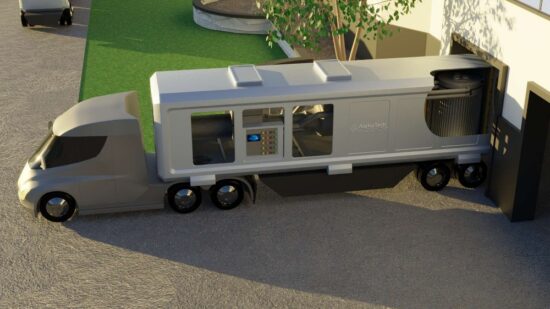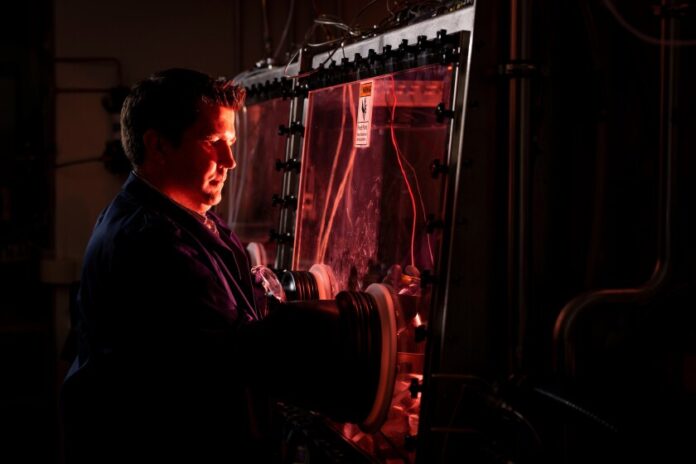Brigham Young University (BYU) nuclear engineer, Matthew Memmott heads up a team that has designed a nuclear reactor with a core that is a mere 1.2 by 2.1 metres (4 by 7 feet). The reactor and all the equipment needed to run it fit on a 12-metre (40-foot) truck flatbed. At that size, the one-truck reactor can power 1,000 homes.
Compare this to the standard nuclear reactors used in the United States today with cores measuring 9.1 square metres (900 square feet) and housed in massive concrete containment buildings. The reason for the latter is to ensure no radiation escapes into the surrounding environment. But the BYU team’s reactor doesn’t need that kind of containment. Instead, the molten salt absorbs all the radioactivity produced with the ability to harvest the captured elements such as molybdenum-99, cobalt-60, gold, platinum, neodymium and others for resale. In other words, no nuclear waste. Another benefit is that hydrogen and oxygen produced during the nuclear reaction can also be harvested from the salt. This means the cost of operations can be offset through the resale of these valuable elements and hydrogen can be a clean-fuel alternative to replace gasoline. Once harvested, the molten salt becomes clean and completely reusable.
Memmott compares the evolution of nuclear reactor technology to the computer revolution. Our early post-World War Two computers used giant vacuum tubes and filled entire rooms. Then the transistor was invented. And later on, transistors got smaller and smaller eventually being placed on silicon chips. Laptop computers and smartphones today are analogous to Memmott’s molten salt reactor. They may not be equivalent in computing power to much larger machines, but they have enough horsepower to help consumers run businesses and homes. Meanwhile, we still have mainframe legacy computers equivalent to Generation One nuclear power plants in Memmott’s analogy.
An article appearing on the BYU website quotes him on the merits of this nuclear power plant design. “For the last 60 years, people have had the gut reaction that nuclear is bad, it’s big, it’s dangerous. Those perceptions are based on potential issues for Generation One, but having the molten salt reactor is the equivalent of having a silicon chip. We can have smaller, safer, cheaper reactors and get rid of those problems.”
This micro-molten salt reactor will not have a meltdown. The radioactive byproducts produced by the nuclear reaction dissolve in the molten salt rather than being absorbed by conventional fuel rods. The molten salt’s extremely high melting point of 550 Celsius (1,022 Fahrenheit) makes it an ideal medium to absorb the heat from these byproducts with the temperature of the salt rapidly falling and causing crystallization. This traps the radioactive elements to make them easy to harvest.
Size and portability make the reactor another candidate for powering remote and isolated communities like those found in Alaska and the Canadian Arctic. Many of these communities are smaller than 1,000 homes and one flat-bed delivered reactor could keep the lights and heat on, replacing expensive and bulky diesel fuel that these communities use today.
A BYU spinoff, Alpha Tech Research Corp., features the reactor on its website. The reactor has been named the ARC Generator with 12 Megawatts of capacity running on uranium fuel with fluoride salt. It does not require high-pressure containment structures used by conventional nuclear reactors that prevent coolant from boiling off. And even though it operates at a temperature of 700 Celsius (1,292 Fahrenheit), if it loses power, radiation is safely contained by the molten fluoride salt which freezes.
The ARC Generator can provide baseload power or be combined with wind and solar to meet a remote community’s energy needs. It can operate both off or on the grid and is transportable, capable of being taken almost anywhere in its secure housing (see image below).

Micro-molten salt reactors are among the Generation Two reactors being promoted by the nuclear industry. These small modular designs are giving nuclear power a new sense of purpose, and when combined with renewable energy technologies represent a good solution to achieve net-zero emissions by 2050.















